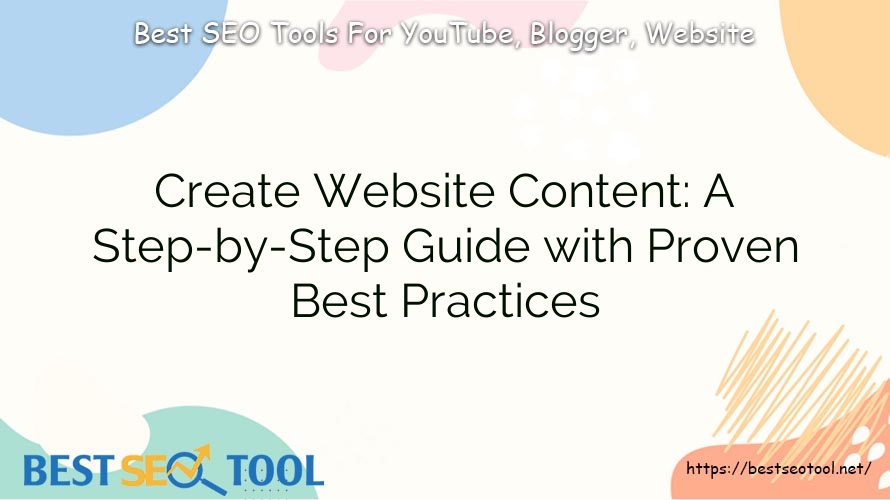SEO Content
Create Website Content: A Step-by-Step Guide with Proven Best Practices
When it comes to your website, your content is what sets the stage for your brand. It’s your first impression, and it needs to grab your target audience’s attention, engage visitors, and drive conversions. Whether you’re selling products, offering services, or simply sharing information, the right content can guide potential customers through their decision-making process and toward a desired action.
In this article, I’ll provide you with a comprehensive guide on creating compelling website content, along with 5 best practices to ensure your content goes beyond good and becomes exceptional.
Understanding Website Content

Website content encompasses any material—written, visual, or interactive—that appears on your site. Its purpose is to inform, engage, and convert visitors. Different types of content serve unique purposes across various web pages:
- Short-form copy: Homepages, product descriptions, and calls to action
- Blog articles: In-depth articles
- Infographics: Visuals simplifying complex information
- Interactive content: Quizzes and forms
- Landing pages: Conversion-focused pages to capture leads or prompt specific actions
- Thought leadership content: High-quality articles, interviews, or opinion pieces
- Premium content: Ebooks and white papers
A mix of engaging written content, compelling visuals, and interactive elements can create a more dynamic user experience. This guides visitors seamlessly through their buying journey—from discovering your brand to becoming loyal customers.
Essential Pages and Content for Your Website
To create a comprehensive website, you need engaging content across different pages. Here are the essential pages and content your website should have:
Homepage
Your homepage is your digital front door, providing visitors with a clear snapshot of who you are, what you offer, and what action you want them to take. Keep in mind that almost 80% of visitors scan website content, so your homepage must have short, concise, and persuasive copy that quickly communicates key messages.

Use strategic visuals, bold headlines, and clear calls-to-action (CTAs) to capture readers’ attention and drive engagement. For example, Trello’s homepage effectively uses a simple headline, strategic imagery, and prominent CTAs to convey the app’s value proposition and encourage user action.
About Us Page
An “About Us” page should go beyond describing your business; it should tell your story. Include your mission statement, vision, company history, and team introduction to help visitors understand your values, build credibility, and showcase your experience.

Use this page to connect with your audience, highlighting what makes your company unique. A great example is Wag!, which communicates its mission, shares a growth timeline, and introduces its team to foster trust among pet owners looking for reliable care services.
Service/Product Page(s)
Each core offering should have its dedicated page, focusing on benefit-driven content that shows how your product or service solves problems or adds value. Use compelling visuals to highlight features and engage visitors. Include a strong CTA to prompt the next step, whether it’s a purchase, consultation, or newsletter signup.

Effective service or product pages turn curiosity into conversions. Apple exemplifies this with product pages that combine benefit-focused content, stunning visuals, and clear CTAs to drive action.
Blog/Resource Center
A robust blog or resource center is a powerful tool for building authority and connecting with your target audience. Regularly publishing high-quality content that addresses your readers’ questions and concerns establishes your brand as a trusted information source.

Blogs drive traffic and foster loyalty and engagement. Including an FAQ section within your resource center can address immediate concerns and provide quick access to crucial, relevant information. Readily available answers increase the likelihood of conversion. Asana’s resource hub offers articles, reports, videos, and webinars to enhance productivity and showcase project management expertise.
Contact Page
Your contact page is a vital bridge between your business, prospective clients, and actual customers. Offer multiple contact options like email, phone, and live chat to ensure visitors can reach out in their preferred way, improving user satisfaction and engagement.

Email forms can prevent spam, manage inquiries efficiently, and build an email list for future marketing purposes. HubSpot’s contact page offers several ways for users to contact them, including live chat, phone numbers, and a fax number.
Customer Stories and Testimonials
Customer testimonials and case studies are powerful for building credibility and trust. Almost 90% of consumers trust word-of-mouth recommendations, making testimonials a vital part of your website content strategy. Feature testimonials that highlight customer satisfaction and success prominently on your website.

Craft case studies showcasing how your product/service solved a problem or delivered exceptional results to provide tangible proof of your value and convert visitors into clients. Shopify showcases various customer testimonials and case studies, demonstrating their platform’s success and building trust with potential users.
9 Essential Steps to Create Website Content
Creating high-quality website content requires a strategic approach. Follow these nine essential steps to craft valuable content that captures attention, drives engagement, and increases your conversion rate:
Understand Your Audience
Understanding your target audience is key to creating content that resonates. Research their preferences, challenges, and needs to grasp what truly matters to them. Develop detailed reader personas that outline demographics, interests, and online behavior.

Create content tailored to different audience personas. This approach builds trust and fosters a connection by addressing your audience’s needs.
To build your persona, you can use free tools such as Hubspot’s Make My Persona or Miro persona templates.
Develop a Brand Voice and Style Guide
A consistent brand voice builds a recognizable and relatable identity. Base your brand voice on audience insights—what tone resonates best with them? To maintain this consistency, develop a comprehensive style guide to standardize tone of voice, typography, formatting, image guidelines, grammar, word usage, and point of view.

Mailchimp’s style guide clearly defines its brand voice, including guidelines on tone, typography, accessibility, and more, to maintain a consistent brand presence across all platforms.
Define Your Unique Selling Proposition (USP)
Your USP sets your brand apart by providing a unique benefit or value that only you can offer. Highlight your USP prominently on key pages to immediately communicate what makes your brand special. Ensure your USP speaks to your target audience, addressing their needs or pain points to maximize impact. Nerd Fitness offers an inclusive, fun, and engaging approach to fitness with a welcoming community and personalized guidance for those who feel out of place in traditional gyms.
Research Relevant Keywords
Keywords connect what your audience is searching for to your content. Use relevant keywords strategically throughout your content to align with your audience’s search behavior and intent. Incorporate these SEO keywords across your website, blog posts, and other content to match different search intents and attract more traffic.
Tools like Google Search and Surfer can help you find relevant keywords and assess key metrics like keyword difficulty and search volume.
Develop a Content Strategy
A solid content strategy begins with understanding your audience and using keyword research to determine what content resonates most. Conduct brainstorming sessions and research competitors’ content to uncover effective formats and topics that inspire new content strategies and enhance audience engagement. Create content clusters—interlinked pieces supporting a central topic—to streamline planning and boost SEO.
Write Your Web Copy
When creating website content, start with short-form web copy. This includes key pages like the homepage, About Us page, and product and services pages. These pages set the tone for your website and are often the first content visitors see, so getting them right is crucial. Keep your content concise and to the point. Provide value by highlighting benefits over features when discussing products and services. Use relevant keywords strategically to enhance SEO. Craft clear CTAs to guide visitors to the desired action.
Create High-Quality Blog Posts
A strong blog is vital for building authority and improving search results. Blogs provide a platform to share valuable, people-first content that prioritize helpfulness, clarity, unique insights, and authoritative data. Consider leveraging AI tools like Surfer to streamline the content creation process by generating high-quality and SEO-optimized articles.
Optimize Content for Search Engines
To ensure your content reaches the right audience, you must follow SEO best practices. Add relevant keywords to the URL, meta title, meta description, headings, and body copy. Use optimized alt text for images to boost search engine optimization and accessibility. Have a solid internal linking strategy to keep users engaged longer and to build topical authority. Tools like Surfer’s Content Editor can assist you in identifying the right keywords to include and optimizing your content for search engines.
Monitor and Improve Your Content
Creating quality content is just the beginning. Continuously monitor its performance using analytics tools like Google Search Console and Google Analytics. Track important metrics such as impressions, clicks, rankings, and bounce rate. This data provides valuable insights into what’s working and what areas need improvement. Regularly update your existing content to keep it relevant, optimized for search engines, and valuable to your target audience. Tools like Surfer’s Content Audit can help you identify improvement opportunities and optimize your content further.
5 Best Practices for Website Content Creation
Follow these website content best practices to elevate your copy, engage readers, rank well on search engines, and drive meaningful results:
Focus on Headlines and Hero Sections
Create clear, concise, and attention-grabbing headlines that promise value. Use numbers, questions, and intriguing statements to attract readers and boost click-through rates. Similarly, the hero section—the prominent area at the top of your page—should immediately engage visitors. It often includes a bold headline, subheadline, and a compelling CTA.
Ensure Readability and Skimmability
Make your content easy to read and skim by using subheadings, bullet points, short paragraphs, and highlighted important points with bold or italicized text. Simplify language and use short sentences to improve accessibility.
Leverage Captivating Visuals
Include visually appealing images, infographics, and videos to break up text and enhance understanding and information retention. Optimize images for faster loading time without sacrificing quality.
Make Your Content Mobile-Friendly
Ensure your content is easily accessible and legible on small screens. Test it across different devices for a consistent user experience. Mobile devices receive a significant share of web traffic, so optimizing for mobile is crucial.
Streamline Your Content Production Workflow
Use tools like Surfer to streamline your content production workflow. Automate repetitive tasks, maintain a steady content pipeline, and focus more on creating high-quality, engaging content that drives results.
Achieving Effective Website Content
To create impactful website content, focus on delivering value through well-researched, engaging, and user-centric material. Prioritize quality, relevance, and SEO best practices to improve your website’s performance. Tools like Surfer can help optimize your content, resonate with your audience, and drive better results. Try Surfer today and start climbing the SERPs.
About Best SEO Tool
At Best SEO Tool, we provide the best group buy SEO Tool service. Our tools offer a wide range of features to optimize your website content, conduct keyword research, monitor analytics, and improve your search engine rankings. With our reliable and affordable service, you can take your SEO efforts to the next level. Visit our website today to explore our tool options and enhance your SEO strategy.

